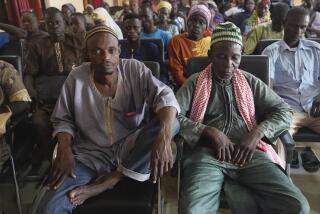Ancient Mossi Dynasty Coexists With Modern Trappings in Burkina Faso
- Share via
OUAGADOUGOU, Burkina Faso — As the early morning sun rises over dusty parapets, the king emerges from his mud palace wearing scarlet robes and clutching a long sword.
He strides toward a stallion reined in by a young courtier while several noblemen scurry behind. The king is preparing to wage war despite the fears of his followers. “Don’t go,” the attendants plead in low, melodic voices.
After a short debate, the ruler, the Mogho Naba, reluctantly agrees to abandon his war. After all, he concedes, leaders need to remain alive to serve their people.
It is a centuries-old story, but one that is reenacted every Friday morning by the Mogho Naba at his palace in Ouagadougou, the shambling capital of impoverished, wind-swept Burkina Faso.
The ritual symbolizes the survival struggle of the 900-year-old Mossi monarchy, which is shared among four kings and is one of Africa’s oldest and most resilient dynasties even though the nation is legally a republic.
After braving nearly a millennium of attacks by Arab and Berber armies, white French colonial masters and latter-day African dictators, Mossi kings and chiefs now face their toughest foe--modern society.
In the last three decades, Burkina Faso’s cities have adopted many trappings of modern life. Growling motorcycles and mopeds have replaced donkey carts. At night, young people fill discos that throb with reggae and dance tunes.
Even people in remote, dusty villages, where living standards remain among the world’s lowest and most people raise goats and grow meager crops of millet and sorghum, have been shown a glimpse of the outside world. The government recently began pitching televisions to villagers in a bid to restore flagging national spirits.
The Mossi animist religion of worshiping ancestors and offering animal sacrifices has finally begun giving way to Islam after surviving centuries of Muslim conversion attempts.
A Mossi chief, Larle Naba Tigre, believes Islamic beliefs can coexist with animism--the Mogho Naba himself is a Muslim who also performs traditional rites. But the chief complains: “It is unacceptable that some people no longer offer sacrifices to our ancestors.”
Despite the waning traditions and a lack of specified powers under the constitution, the Mossi kings and chiefs retain considerable influence in Burkina Faso’s government because of their strong support among the majority Mossi people.
The hereditary Mossi aristocracy also have power to make judicial decisions in their communities and are often consulted by Parliament and the Cabinet. The kings and chiefs have feudal title over significant landholdings.
President Blaise Campaore, himself a Mossi, rose to power in a bloody 1987 coup that killed a popular yet controversial socialist president, Thomas Sankara.
The Mossi leaders were pleased with the coup and supported Campaore, who reversed Sankara’s campaign to isolate and weaken tribal authorities.
“Sankara was wrong to act against us, and he paid for that,” Larle Naba Tigre said.
The Mossi kings retain a “defense ministry” to deter potential enemies and can rally thousands of warriors if necessary. In the mid-1960s, Mossi swordsmen gathered in Ouagadougou to protest then President Maurice Yameogo’s government.
“We showed the strength of our swords,” Larle Naba Tigre said.
The Mossi live throughout much of Burkina Faso, a landlocked country the size of Colorado, and make up more than half its 10 million people. The Mossi language, More, is the country’s predominant tongue.
Like other chiefs and kings, Larle Naba Tigre is a respected figure who holds audience every week with officials and peasants seeking advice on everything from raising livestock to making political decisions.
As he met with a foreign journalist, a throng of followers waited patiently outside, kneeling on hard stone steps. They bowed to the ground when they saw him.
“I consult with my community and find traditional solutions to their problems,” the chief said.
Since the 11th century, the Mossi have retained their customs by carefully passing down their history by word of mouth. Tales of the first great Mossi conqueror, the 14th century Mogho Naba Rawa, are told by fathers to sons.
On a wall of Larle Naba Tigre’s house, an artist has carved relief portraits of ancient warriors with flowing robes similar to those still worn by the Mossi. Strings of cowrie shells snake across the walls, tracing more than 60 generations of royal lineage.
As he showed a visitor around his mansion, which includes a traditional burial chamber and a public meeting room, the chief recited words of wit and folklore.
Each of his riddles seemed linked to the survival of the Mossi culture.
“We cannot live with the memories of others,” he said. “We must have our own memories.”
More to Read
Sign up for Essential California
The most important California stories and recommendations in your inbox every morning.
You may occasionally receive promotional content from the Los Angeles Times.













